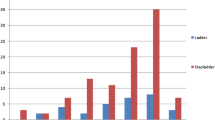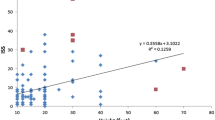Abstract
Purpose
It is undisputed for more than 200 years that the use of a parachute prevents major trauma when falling from a great height. Nevertheless up to date no prospective randomised controlled trial has proven the superiority in preventing trauma when falling from a great height instead of a free fall. The aim of this prospective randomised controlled trial was to prove the effectiveness of a parachute when falling from great height.
Methods
In this prospective randomised-controlled trial a commercially acquirable rag doll was prepared for the purposes of the study design as in accordance to the Declaration of Helsinki, the participation of human beings in this trial was impossible. Twenty-five falls were performed with a parachute compatible to the height and weight of the doll. In the control group, another 25 falls were realised without a parachute. The main outcome measures were the rate of head injury; cervical, thoracic, lumbar, and pelvic fractures; and pneumothoraxes, hepatic, spleen, and bladder injuries in the control and parachute groups. An interdisciplinary team consisting of a specialised trauma surgeon, two neurosurgeons, and a coroner examined the rag doll for injuries. Additionally, whole-body computed tomography scans were performed to identify the injuries.
Results
All 50 falls—25 with the use of a parachute, 25 without a parachute—were successfully performed. Head injuries (right hemisphere p = 0.008, left hemisphere p = 0.004), cervical trauma (p < 0.001), thoracic trauma (p < 0.001), lumbar trauma (p < 0.001), pelvic trauma (p < 0.001), and hepatic, spleen, and bladder injures (p < 0.001) occurred more often in the control group. Only the pneumothoraxes showed no statistically significant difference between the control and parachute groups.
Conclusions
A parachute is an effective tool to prevent major trauma when falling from a great height.


Similar content being viewed by others
References
Mertens J (2002) Technology as the science of the industrial arts: Louis-Sébastien Lenormand (1757–1837) and the popularization of technology. Hist Technol 18:203–223
Søreide K (2012) The epidemiology of injury in bungee jumping, BASE jumping, and skydiving. Med Sport Sci 58:112–129
Smith GC, Pell JP (2003) Parachute use to prevent death and major trauma related to gravitational challenge: systematic review of randomised controlled trials. BMJ 20:1459–1461
Agency for Health Care Policy and Research, Department of Health and Human Services (1992) Acute pain management: operative or medical procedures and trauma. Clinical practice guideline no. 1. AHCPR Publication 92–0032. AHCPR 100-7, Rockville
Sackett DL, Rosenberg WM, Gray JA, Haynes RB, Richardson WS (1996) Evidence based medicine: what it is and what it isn´t. BMJ 13:71–72
Layton TR, Villella ER, Kelly EG (1981) High free fall with survival. J Trauma 21:983–985
Nelson KS, Brearley AM, Haines SJ (2014) Evidence-based assessment of well-established interventions: the parachute and the epidural hematoma. Neurosurgery 75:552–559
Chesnut RM, Temkin N, Carney N et al (2012) A trial of intracranial-pressure monitoring in traumatic brain injury. N Engl J Med 367:2471–2481
http://www.dwd.de German Weather Service, Federal Ministry of Transport and Digital Infrastructure. Data acquired on 8th July 2015
Vaccaro AR, Oner C, Kepler CK et al (2013) AOSpine thoracolumbar spine injury classification system: fracture description, neurological status, and key modifiers. Spine (Phila Pa 1976) 38:2028–2037
WMA Declaration of Helsinki-Ethical Principles for Medical Research Involving Human Subjects. World Medical Association, Ferney-Voltaire, France
http://www.gesetze-im-internet.de/tierschg/BJNR012770972.html Animal health and welfare act of the Federal Republic of Germany in the version published from May 18th 2006 (BGBl. I S. 1206, 1313), last updated with article 3 from July 28th 2014 (BGBl. I S. 1308) data acquired on 8th July 2015
Hart CL, Griffith JD, Randell JA (2006) An analysis of U.S. parachuting fatalities: 2000–2004. Percept Mot Skills 103:896–900
Lee CT, Williams P, Hadden WA (1990) Parachuting for charity: it is worth the money? A 5-year audit of parachute injuries in Tayside and the cost to the NHS. Injury 30:283–287
Bricknell MC, Craig SC (1999) Military parachuting injuries: a literature review. Occup Med (Lond) 49:17–26
Belmont PJ Jr, Taylor KF, Mason KT, Shawen SB, Polly DW Jr, Klemme WR (2001) Incidence, epidemiology, and occupational outcomes of thoracolumbar fractures among US Army aviators. J Trauma 50:855–861
Laczkowski G, Hasenfuss S, Verhoff M, Weiler G (2002) An ususal airplane crash-deadly life saver. Unintentional activation of an automated reserve opening device causing airplane accident. Forensic Sci Int 125:250–253
Hasler RM, Huttner HE, Keel MJ et al (2012) Spinal and pelvic injuries in airborne sports: a retrospective analysis from a major Swiss trauma centre. Injury 43:440–445
Vaccaro AR, Schroeder GD, Kepler CK, Cumhur Oner F, Vialle LR, Kandziora F, Koerner JD, Kurd MF, Reinhold M, Schnake KJ, Chapman J, Aarabi B, Fehlings MG, Dvorak MF (2015) The surgical algorithm for the AOspine thoraclumbar spine injury classification system. Eur Spine J. doi:10.1007/s00586-015-3982-2
Author information
Authors and Affiliations
Corresponding author
Ethics declarations
Conflict of interest
All authors declare that they have no financial or other conflicts of interest in relation to this study and its publication.
Additional information
P. Czorlich and T. Burkhardt contributed equally to this manuscript.
Rights and permissions
About this article
Cite this article
Czorlich, P., Burkhardt, T., Buhk, J.H. et al. Does usage of a parachute in contrast to free fall prevent major trauma?: a prospective randomised-controlled trial in rag dolls. Eur Spine J 25, 1349–1354 (2016). https://doi.org/10.1007/s00586-016-4381-z
Received:
Revised:
Accepted:
Published:
Issue Date:
DOI: https://doi.org/10.1007/s00586-016-4381-z




